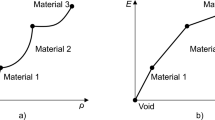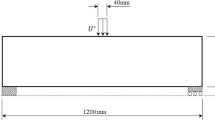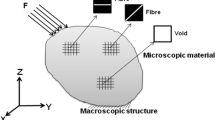Abstract
A discrete material optimization method with a patch strategy based on the stiffness matrix interpolation is proposed, and a comprehensive technical process of patch discrete material optimization using existing finite element software was developed. This method employs the stiffness matrix instead of the constitutive matrix for material interpolation, which facilitates the optimization process integrated with the existing finite element software. The element stiffness matrix can be derived directly from the finite element analysis, which can not only ensure the correctness of the data, but also reduce the programming work of solving the numerical integration of the composite constitutive matrix. The mathematical model of the patch discrete material optimization is established, which takes the artificial density as the design variable, the minimum compliance as the objective function, and the sequential quadratic programming (SQP) algorithm as the optimization solver. Numerical examples show that by seeking a balance between the number of regions and practical production, the performance of the composite could be further improved using the discrete material optimization method with a patch strategy. Besides, the convergence rate of the optimization is increased by introducing the sum constraints of the design variables and the value functions. The effectiveness and the feasibility of the method were verified.
Similar content being viewed by others
Abbreviations
- D :
-
Elastic matrix of the element
- K :
-
Overall stiffness matrix of the structure
- B :
-
Strain matrix
- α :
-
Penalty parameter
- X :
-
Design variable array
- C :
-
Compliance of the structure
- X i,j :
-
Design variables of material j at region i
- ω i,j :
-
Weight function concerning the ith candidate material
- f(x):
-
Objective function
- h(x), g(x):
-
Constraint functions
- ∇():
-
Gradient vector of each function
- W :
-
Hessian matrix of the Lagrange function
- ϕ(x):
-
1-norm value function
References
E. Lund, Buckling topology optimization of laminated multimaterial composite shell structures, Composite Structures, 91(2) (2009) 158–167.
E. Lund and J. Stegmann, On structural optimization of composite shell structures using a discrete constitutive parametrization, Wind Energy, 8(1) (2005) 109–124.
J. Stegmann and E. Lund, Discrete material optimization of general composite shell structures, International J. for Numerical Methods in Engineering, 62(14) (2005) 2009–2027.
C. F. Hvejsel and E. Lund, Material interpolation schemes for unified topology and multi-material optimization, Structural and Multidisciplinary Optimization, 43(6) (2011) 811–825.
C. F. Hvejsel, E. Lund and M. Stolpe, Optimization strategies for discrete multi-material stiffness optimization, Structural and Multidisciplinary Optimization, 44(2) (2011) 149–163.
B. Niu, N. Olhoff, E. Lund and G. Cheng, Discrete material optimization of vibrating laminated composite plates for minimum sound radiation, International J. of Solids and Structures, 47(16) (2010) 2097–2114.
C. Wu, Y. Gao, J. Fang, E. Lund and Q. Li, Discrete topology optimization of ply orientation for a carbon fiber reinforced plastic (CFRP) laminate vehicle door, Materials and Design, 128 (2017) 9–19.
Z. Duan, J. Yan and G. Zhao, Integrated optimization of the material and structure of composites based on the Heaviside penalization of discrete material model, Structural and Multidisciplinary Optimization, 51(3) (2015) 721–732.
S. N. Sørensen, R. Sørensen and E. Lund, DMTO-a method for discrete material and thickness optimization of laminated composite structures, Structural and Multidisciplinary Optimization, 50(1) (2014) 25–47.
S. N. Sørensen and M. Stolpe, Global blending optimization of laminated composites with discrete material candidate selection and thickness variation, Structural and Multidisciplinary Optimization, 52(1) (2015) 137–155.
J. H. Sjølund, D. Peeters and E. Lund, A new thickness parameterization for discrete material and thickness optimization, Structural and Multidisciplinary Optimization, 58(5) (2018) 1885–1897.
E. Lund, Discrete material and thickness optimization of laminated composite structures including failure criteria, Structural and Multidisciplinary Optimization, 57(6) (2018) 2357–2357.
J. H. Sjølund, D. Peeters and E. Lund, Discrete material and thickness optimization of sandwich structures, Composite Structures, 217 (2019) 75–88.
X. Ma, K. Tian, H. Li, F. Wang and P. Hao, Diverse discrete material optimization for multi-patch laminates under vibration environment, Structural and Multidisciplinary Optimization, 62 (2020) 1905–1925.
A. Sohouli, M. Yildiz and A. Suleman, Design optimization of thin-walled composite structures based on material and fiber orientation, Composite Structures, 176 (2017) 1081–1095.
J. Yan, Z. Duan, E. Lund and J. Wang, Concurrent multi-scale design optimization of composite frames with manufacturing constraints, Structural and Multidisciplinary Optimization, 56(3) (2017) 519–533.
J. Yan, Z. Duan, E. Lund and G. Zhao, Concurrent multi-scale design optimization of composite frame structures using the Heaviside penalization of discrete material model, Acta Mechanica Sinica, 32(3) (2016) 430–441.
Z. Duan, J. Yan, I. Lee, E. Lund and J. Wang, A two-step optimization scheme based on equivalent stiffness parameters for forcing convexity of fiber winding angle in composite frames, Structural and Multidisciplinary Optimization, 59(6) (2019) 2111–2129.
M. P. Bendsøe, Optimal shape design as a material distribution problem, Structural Optimization, 1(4) (1989) 193–202.
M. Li, G. Bai and Z. Wang, Time-variant reliability-based design optimization using sequential kriging modeling, Structural and Multidisciplinary Optimization, 58(3) (2018) 1051–1065.
M. Yang, D. Zhang, C. Cheng and X. Han, Reliability-based design optimization for RV reducer with experimental constraint, Structural and Multidisciplinary Optimization, 63(4) (2021) 2047–2064.
W. Sun and Y. Yuan, Optimization Theory and Methods Nonlinear Programming, Springer, New York (2006).
Acknowledgments
This work was supported by National Natural Science Foundation of China (Grant no. 51865041 and 52165035), the Natural Science Foundation of Inner Mongolia Autonomous Region of China (Grant no. 2020MS05022 and 2019MS05070) and the State Key Laboratory of Fluid Power and Mechatronic Systems (Grant no. SKLoFP_ZZ_2102).
Author information
Authors and Affiliations
Corresponding author
Additional information
Pengwen Sun is a Professor of Mechanical Engineering, Inner Mongolia University of Technology, Hohhot, P. R. China. He received his Ph.D. in Power Machinery and Engineering from Beijing Institute of Technology. His research interests include structure design and optimization, wind turbine blade.
Rights and permissions
About this article
Cite this article
Sun, P., Zhang, J., Wu, P. et al. A discrete material optimization method with a patch strategy based on stiffness matrix interpolation. J Mech Sci Technol 36, 797–807 (2022). https://doi.org/10.1007/s12206-022-0127-5
Received:
Revised:
Accepted:
Published:
Issue Date:
DOI: https://doi.org/10.1007/s12206-022-0127-5




